If you’re bringing home a new labradoodle puppy, you may be wondering what you need to know about their growth, developmental milestones, and how to properly raise them. Our guide on labradoodle progression has you covered with the crucial foundations you need to know to raise a healthy and happy pup.
Read on to learn more!
Labradoodle: Breed Summary
Currently, no major kennel club or association, including the AKC, recognizes the “labradoodle” as a distinct breed. Rather, these associations still recognize them as resulting from either a cross between labradors and standard poodles or a cross between the labrador, standard poodle, and other breeds such as the cocker spaniel (Australian labradoodle).
The history of intentionally creating labradoodles dates back to the 1980s in Australia when an assistance dog company sought to produce a dog with “allergy-friendly” coat types and a gentle, assistance dog temperament. However, it’s important to note that current scientific data does not support the claim that poodle coats are “hypoallergenic”. In fact, one study found that households with purebred dogs claimed as hypoallergenic contained essentially the same level of dog allergens as purebred dogs not claimed to be hypoallergenic.
Breed Standards?
Because no major kennel club currently accepts this breed, there is no official breed standard. Typically, breeders tend to select for producing textured, poodle-like coat types. Other than this, you can find quite a variation in features as some labradoodles tend to have more poodle-like faces while others appear more like labs. Breeders do typically aim for creating more of a labrador facial structure.
One study found that Australian labradoodles contain an excess of poodle DNA due to the favoring of creating poodle-type coats. This study also found that Australian labradoodles have more genetic variation in them compared to non-Australian labradoodles, with many of the former individuals containing the genetic addition of the miniature poodles, English cocker spaniel, American cocker spaniel, and Irish water spaniel.
Note, we will use the term “breed” in this article to refer to labradoodles but remember that they are not yet officially recognized as purebred dogs. Australian labradoodles may be closer on the path to this recognition than non-Australian labradoodles due to their increased genetic diversity across many generations. We will also be talking about “standard” labradoodles rather than the various other sizes you may find mentioned.

A labradoodle with a neatly groomed, poodle-type coat
©iStock.com/EvgeniiAnd
Labradoodle Sizes Ranges
Because there are no official standards, including for size, for labradoodles, it’s a bit more tricky to offer a specific growth chart. You may find that the growth rate of your pup, especially for Australian labradoodles that can have more breed ancestral diversity, can deviate quite a bit from growth charts you find online.
Additionally, some breeders claim to produce “miniature” and “medium” sizes of labradoodles. Although, again, there are no official breed standards or set methods for producing these various sizes.
Purebred adult male labradors can weigh 65-90 pounds, while females can weigh 55-70 pounds as per the AKC standards. In comparison, an adult standard male poodle can weigh 60-70 pounds, while an adult female can weigh 40-50 pounds. So, the size of your pup will depend on what generation of labradoodle puppy you have (how far many generations they are away from the first crossing of lab and poodle), and their genetic makeup.
You may care for a standard labradoodle who weighs 40 pounds as a healthy adult while another person may have an equally healthy adult standard labradoodle who weighs 90 pounds.
Labradoodle Progression: When Will My Labradoodle Stop Growing?
As a medium to large-sized dog, your labradoodle will likely reach a max height around 12 months old and a max weight around 18-24 months old. Again, this can vary quite a bit based on the genetics of your mixed-breed pup. You may find that your standard labradoodle will average about 21-24 inches tall at the withers when fully grown, but this can certainly vary.
As your puppy is growing, the best way to make sure they are on track developmentally is through scheduling vet checkups at the 2,4,6,9, and 12-month marks.

Your labradoodle pup may continue growing until they are 2 years old. This pictured adult standard labradoodle is on the smaller end of the size range.
©Jne Valokuvaus/Shutterstock.com
When Should My Labradoodle Be Spayed or Neutered?
The question of when to spay or neuter your pup is quite individual to your dog’s genetics and health history. Larger breed purebred and mixed breed dogs such as labradoodles are at increased risk of developing joint and bone health conditions from early altering, such as hip dysplasia. Labradors are especially prone to an increased risk of developing such joint problems, so that should be taken into account with your labradoodle.
Evidence shows spaying and neutering provide a decreased risk of developing certain cancers of the reproductive system. However, a growing body of evidence also shows that altering can increase the risk of dogs developing other cancers. Some breeds are more at risk than others.
In one large study, evidence shows that male and female labs are at 2-4 times increased risk of developing joint disorders if altered in the first year of their lives. This study did not find an increased risk of cancer for labs altered under 1-year-old compared to intact labs.
This same study also looked at the increased risk of joint disorders and cancers in standard poodles altered under 1 year old. They found that while standard poodles don’t appear to be at risk of developing joint disorders from early spay and neuter, there was a significant increase in risk for males neutered at 1 year in developing lymphosarcoma, a cancerous disease of the white blood cells.
This research won’t translate cleanly for mixed breeds such as labradoodles, but these studies can help your vet make an informed recommendation. Based on these studies, you may find that a vet who is up to date on the latest research might recommend waiting to spay a female labradoodle until 1-year-old and waiting to neuter a male labradoodle until 18-24 months.
When Should My Labradoodle Be Potty Trained?
You can begin potty training your labradoodle puppy at 8 weeks old. When they are this little, they can only hold their bowels for up to 2 hours at a time. No amount of training or management will change how long they can physically hold it, so make sure to take them out consistently before this 2-hour mark. Additionally, it’s important to take them outside immediately after they drink a lot of water and eat their meals. You can use puppy pads at night, but you’ll need to ensure there’s enough space between your pup’s sleeping space and the puppy pads.
You’ll want to form lots of positive associations with your puppy going to the bathroom outside. So, make sure to give them lots of praise, snuggles, treats, play, etc. when they go in the right spot. If your labradoodle puppy has an accident indoors, it’s crucial to not punish, scold, or show disapproval. These methods don’t actually teach your puppy what you’d like them to do and only serve to frighten them. Plus, your puppy may learn that you aren’t safe to use the bathroom around, so they may choose to hide where they go to avoid your unsafe reactions.
Labradoodle Progression: When Should My Labradoodle Stop Eating Puppy Food?
You can transition your labradoodle puppy to adult food around 12-18 months old. Since dogs considered “labradoodles” can grow to quite a range of sizes, it’s best to confirm with your vet when you should transition food for your specific pup. Puppy food provides essential nutrients that growing pups need for healthy development. If you transition to adult food too soon, you can put your puppy at risk of developing bone and joint conditions related to improper nutrition. Always make sure to provide plenty of fresh water throughout your dog’s life.
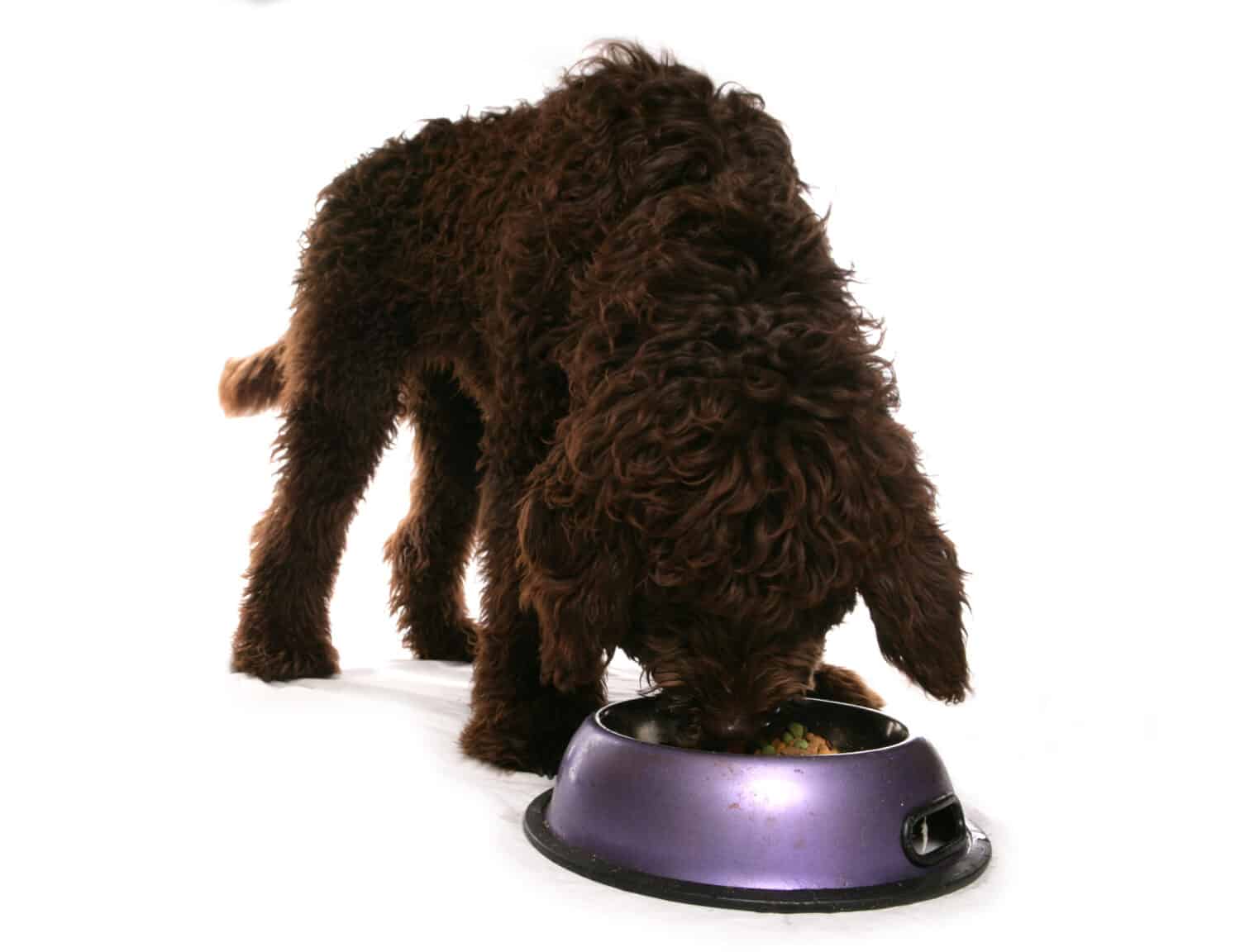
You’ll likely want to transition your labradoodle to adult food between 12-18 months.
©chrisbrignell/Shutterstock.com
Labradoodle Progression: When Will My Labradoodle Lose Their Teeth?
Your labradoodle puppy should start losing their set of 28 baby, or primary, teeth around 12 weeks old. These teeth fall out and give way to the formation of 42 adult, or permanent, teeth. This process should be complete by the time your pup is 6-7 months old. You’ll find that your labradoodle puppy may show an increase in chewing behaviors at this time. This is normal and is in response to the discomfort the adult teeth coming in. It’s important to provide plenty of safe chew toys for your pup to teeth on during this process. You can find all kinds of teething toys and rings for puppies. You can also freeze carrots and similar treats for your pup to chew on.
Management and Addressing Destructive Behaviors
Management can be especially important during teething to help prevent your pup from chewing on inappropriate items. This includes making sure to put out of reach as many objects as you can that you don’t want your pup to chew on. If you do find your pup chewing on an inappropriate item, simply trade them for an appropriate item. This way, your puppy learns that you won’t just take items away from them, which can lead to defensive behaviors, hiding items, and even swallowing unsafe objects.
Or, you can gate off one section of the house to prevent your pup from having access to areas with important items on ground level. Crating is not recommended as a management tool except for overnight, and only if your pup has been properly and positively supported to sleep in a crate. Otherwise, it’s best to use baby gates and other management tools to create a large area to safely contain your pups.
Continuous confinement of dogs (such as with the use of crates and cages) during waking hours can lead to long-term psychological damage and behavioral symptoms. If you are having trouble managing destructive symptoms with your puppy please seek out a qualified fear-free, force-free trainer or behaviorist to help you. These professionals should not use or recommend any aversive tools such as choke or prong collars, shock collars (aka electronic or stim collars), bark collars, or any other punishment-based or aversive training methods.
A growing body of evidence shows that punishment-based methods damage your relationship with your dog, create high risks of fallouts such as defensive behaviors including biting, and lead to long-term psychological stress, including post-traumatic stress.

Remember to trade your labradoodle pup for appropriate items, rather than just taking things away from them.
©sophiecat/Shutterstock.com
When Should I Start Training My Labradoodle?
You can begin teaching your labradoodle puppy crucial life skills that will help them navigate our human world at 8 weeks old. Please note that one of the most important things you can do for your pup is facilitate the development of a secure attachment bond. Research shows that dogs seek out a connection to and safety in their human caregivers similar to the relationship between human babies and their primary caregivers.
Developing a secure attachment bond means your pup will feel deeply safe and know that you are someone they can consistently and successfully seek out for care, safety, comfort, basic needs, affection, play, etc. If your pup is unable to develop this attachment model because you are unavailable, inconsistent, or use aversive training methods, your pup can suffer from long-term psychological damage and develop coping mechanisms that we see as challenging behaviors.
So, while you can begin training life skills with your puppy, please also prioritize developing this crucial secure attachment.
Labradoodle Progression: What Cues and Skills Should I Teach My Labradoodle First?
One of the first cues you can teach any pup, including a labradoodle, is “come”. You can easily encourage your pup to come to you with positive reinforcement. In this context, positive does not mean “good”, but rather the addition of something, ie (+). So, with positive reinforcement, you are adding a reinforcer that your dog really enjoys to increase the likelihood of your pup performing a desired behavior. So, if you pair your pup coming to you with a tasty snack, their favorite toy, etc, your labradoodle is much more likely to feel motivated to come back when you call.
How to Teach “Come”
When your puppy is very young, you only want to train for a couple of minutes a day and make sure the criteria is set low enough that your pup can succeed. So, at first, sit on the floor a few inches from your puppy and encourage them to come interact with you. As soon as they move towards you, give them lots of praise, a treat, and snuggles or play. Once they consistently come over to you when called at this very short distance, you can start using the word “come” as soon as they start heading toward you. This helps to set them up to associate the word with their actions. You may also want to use a hand signal in combo with a verbal cue, such as waving your hand toward yourself, as dogs tend to learn easier with hand cues.
By continuing to use this cue in conjunction with a positive reinforcer, you can teach your pup to recall back to you at increasing levels of distraction and distance. However, you’ll need to ensure that the reinforcer that you use is exciting enough for your pup to want to come back to you over whatever they were doing previously. In low-distraction environments, a lower-value treat may be enough, whereas, in higher-distraction environments, such as a busy park, you may need to use your dog’s favorite, smelliest, most pungent fresh meat or cheese treats.
Key to Successful Positive Reinforcement (R+) Training
The key to success is to gradually increase the criteria, and only move forward if your pup is succeeding. If your pup is struggling, you’ll likely need to lower the difficulty of training and assess what other factors may be contributing, such as too many distractions, pain or health issues, lack of some basic needs being met before training, the positive reinforcer not being valuable enough for the particular task, etc.
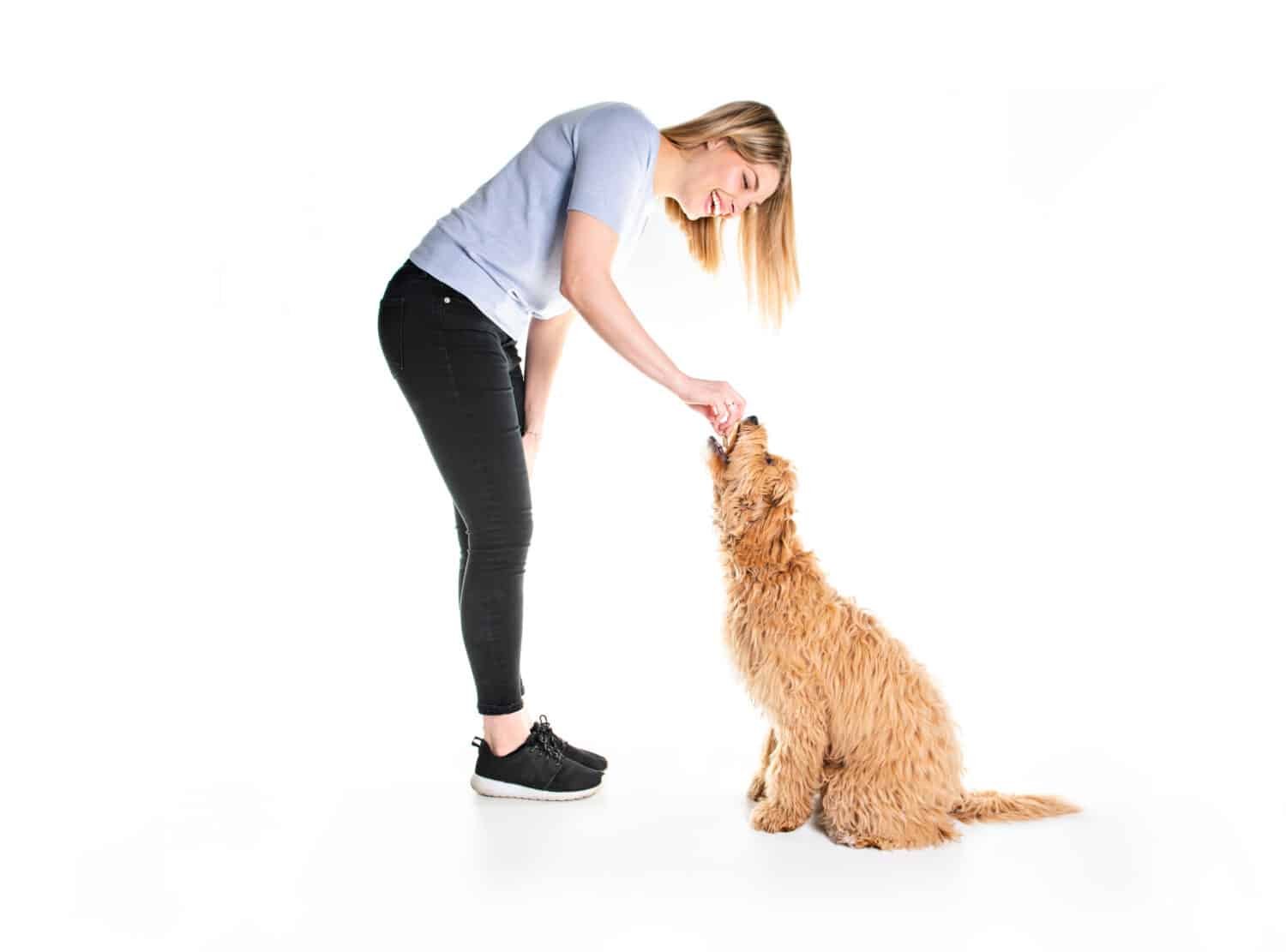
Tasty treats are excellent for positive reinforcement training.
©Lopolo/Shutterstock.com
Other Crucial Skills
Other crucial skills to begin teaching your puppy include cooperative care practices. Cooperative care is the use of consent-based, force-free grooming and vetting in which your pet is an active participant. Dr. Deborah Jones’s book, Cooperative Care: 7 Steps to Stress-Free Husbandry provides a great resource to start learning.
Additionally, using positive reinforcement to teach your pup to trade you items they shouldn’t have (“drop it”) will come in handy, especially in their puppyhood and adolescence.
When Will My Labradoodle Calm Down?
Labradoodles can be quite energetic dogs thanks to their lab genetics. Retriever breeds are well-known for their rambunctious adolescent phase so you could possibly expect the same from your labradoodle. By 3-4 years old, your labradoodle should reach social maturity and transition out of this adolescent phase. You can help ensure your labradoodle doesn’t struggle with hyperactivity by providing appropriate physical and mental stimulation, quality nutrition, maintaining a secure attachment bond, facilitating decompression time, and making sure your pup is getting enough sleep.
Additionally, it’s imperative to provide proper socialization during your puppy’s early socialization period. In this period, from 3-12 weeks of age, your labradoodle puppy’s brain is at its most able to healthily intake and process a myriad of new experiences. Try to introduce your pup to one new thing each day during this developmental period. These introductions should be positive, happy experiences that help your puppy build confidence and feel safe about the world around them. Puppies that don’t have healthy early socialization can have more difficulty feeling calm and relaxed during their adult lives.
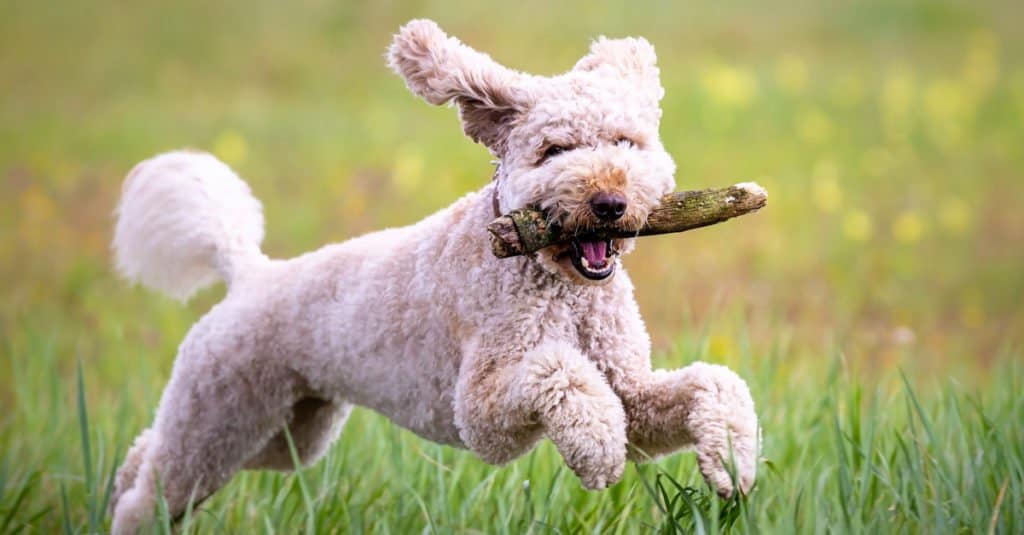
Providing quality physical and mental enrichment, and safe social bonding is crucial to helping your labradoodle feel calm and relaxed.
©Lynxs Photography/Shutterstock.com
Labradoodle Progression: Common Health Issues Your Labradoodle Might Experience
As a mixed breed dog, your labradoodle may be less at risk of developing genetic health issues than purebred dogs. However, rampant backyard and puppy mill breeding of “doodles” has resulted in high occurrences of in-bred dogs who can suffer from a myriad of illnesses resulting from inbreeding. I am always an advocate of adopting from rescues and shelters over purchasing from breeders. If you are choosing to purchase from a breeder, it’s crucial to make sure that the breeder can provide proof of the puppy’s lineage back multiple generations. If they won’t provide proof, this may be a sign that the breeder is not using enough genetic diversity in their breeding lines. While it may take some searching, it’s certainly possible to find labradoodles in need of adoption at rescues and shelters. Some of these pups come into rescues with mothers saved from horrible conditions in puppy mills.
Picture of a Labradoodle Puppy

Cute labradoodle puppy playing with a ball.
©Angeline Dobber/Shutterstock.com
Picture of a 6-Month-Old Labradoodle Puppy
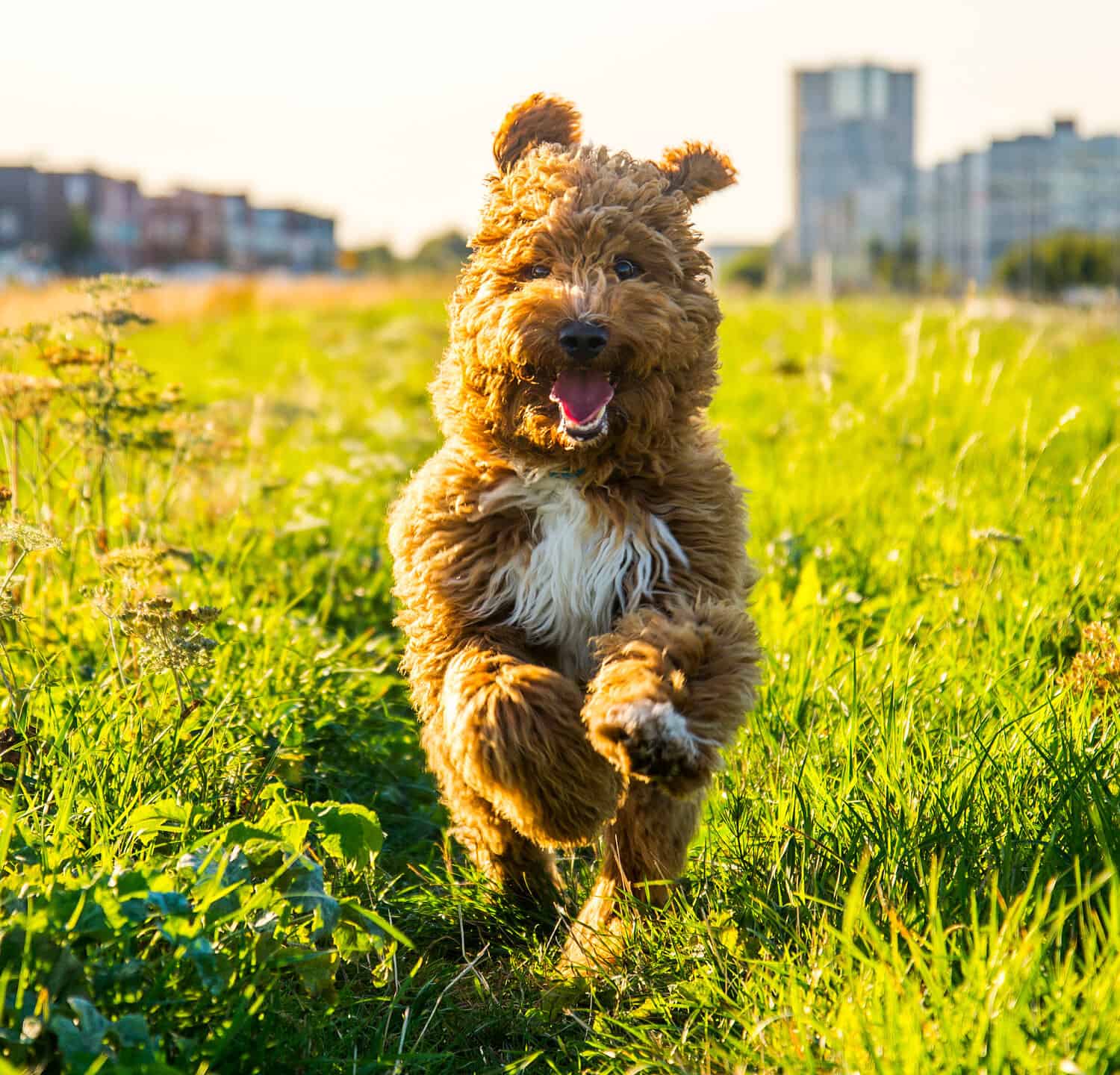
A joyful 6-month-old labradoodle pup.
©Joca de Jong/Shutterstock.com
Picture of an Adult Labradoodle
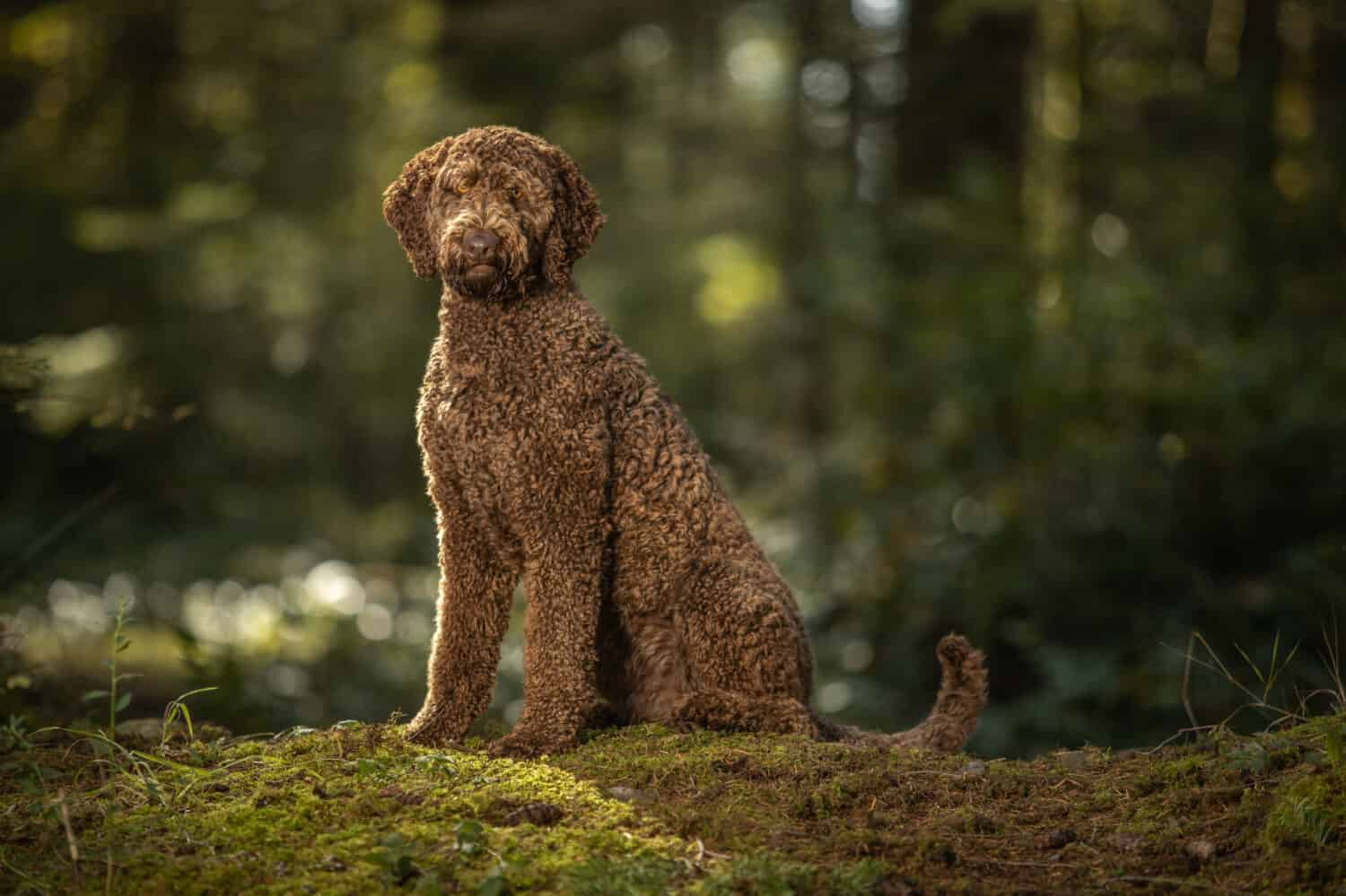
An adult, brown labradoodle in a lovely forest.
©Sharon Snider/Shutterstock.com
The photo featured at the top of this post is © iStock.com/Jennifer McCallum
Ready to discover the top 10 cutest dog breeds in the entire world?
How about the fastest dogs, the largest dogs and those that are -- quite frankly -- just the kindest dogs on the planet? Each day, AZ Animals sends out lists just like this to our thousands of email subscribers. And the best part? It's FREE. Join today by entering your email below.
Thank you for reading! Have some feedback for us? Contact the AZ Animals editorial team.






